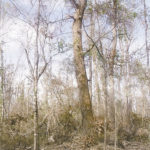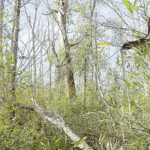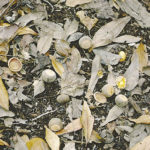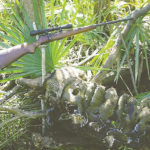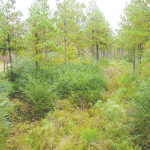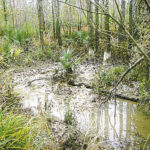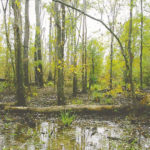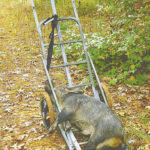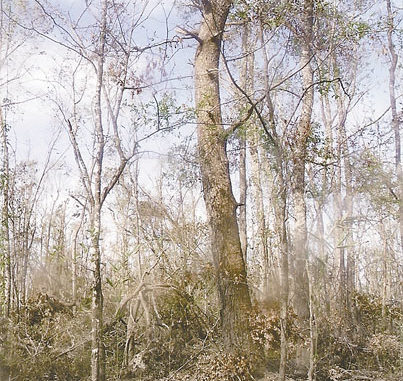
Sometimes it pays to sit in the stand and let the game come to you, and other times it’s better to slip around quietly and find them. Either way, hunting on a wildlife management area can be very productive.
Last season on Pearl River WMA, my focus in the Katrina Woods was browse, primarily blackberry and trumpet creeper vine. I found several areas where the trumpet creeper was being heavily eaten. Other items to focus on are travel trails, especially along the sloughs and bayous.
There was finally a mast crop on Pearl River last year, and this food source was attracting both deer and hogs. I set up on a fallen tree in an area where I had passed up a doe and fawn during the early primitive-season hunt. This area had abundant trumpet creeper browse, and I had watched these deer for about 20 minutes browsing around me.
There were also some water oak and obtusa oak acorns on the ground, and at one point the doe was within 10 feet of me upwind and never got nervous. I may have been the first human it had encountered since the storm.
At daylight, I spotted a big hog moving through the woods, and I thought the bullet from my .444 rifle had done the job, but the blood trail ended in a big tree root ball. When my ace tracker David James Stafford and I approached it, the hog came running out and we never found another drop of blood.
Stafford had been hunting in a stand east of me, and killed a 6-month-old antlerless deer. He was one of the few hunters who harvested deer during this managed deer hunt. The hunter success rate was one deer per 36.7 hunter efforts. Hunters on Pearl River who know how to get around in these hurricane woods do a lot better than those who hunt primarily off the roads and trails.
Weather is always a big factor on managed-hunt days, and the nice weather we had in the early morning turned into a muggy and humid afternoon, and deer and hog movement was poor for the evening hunt.
The next morning, the weather only got worse, so our Pearl River managed hunt ended sooner than we had wanted.
Weather was a big factor on many of the WMAs last year, and heavy rains in several parts of the state resulted in flooded conditions on some of the areas. Bad weather usually means a poor hunter effort, which results in a low deer harvest. If the weather is good and the hunter turnout is good, the deer harvest is also good.
Jackson-Bienville WMA
On the Jackson-Bienville WMA managed hunt last year, my scouting focus was again on the browse species, with privet, honeysuckle and blackberry being the main ones I keyed on. There is a good oak component on this WMA, but most of my hunting is done in the thinned pine plantations where there is plenty of browse and cover. Many hunters target these oak drains because there are feral hogs on this area also, and the oak mast is a drawing card for both deer and hogs.
Stands can be brought onto an area the day prior to the opening day of the deer season, but cannot be left in the hunting position overnight.
My November hunt on Jackson-Bienville resulted in a hog for the freezer. I hunted from a climber along a woods road on the edge of a pine plantation that had been thinned a couple of years ago. The privet shrubs were being heavily browsed by the deer, and the trails were being heavily traveled. About an hour or so after daylight, I saw some pigs cross the trail to the north, so I took my Primos Hog Call, and made a series of snorts and pig grunts. Within a few minutes, I had pigs around and under me.
I put the crosshairs on the back of one, pulled the trigger and the hog dropped dead in its tracks. After bringing the pig out and cleaning it, we went back for the afternoon hunt, but once again the weather turned wet, and we called it a day.
The overall success rate for hunters on this two-day hunt was quite good — one deer per 8.3 hunter efforts. The rut on Jackson-Bienville is later than what normally occurs in Area 2; rather than peak breeding during November, the peak breeding on Jackson-Bienville is in December.
Stand hunting
During the managed deer hunts, it is probably best to set up a stand and hunt from it rather than trying to slip around and find game. The managed-hunt days are the busiest time on these areas, and hunter turn-out is usually good. Because of this, there could be a lot of hunter movement, and stalking or slipping through the woods generally disturbs the hunters in the stands. Of course, stand hunting is the safest method of hunting even though hunters have to wear an orange vest and hat.
The key to stand hunting on managed-hunt days is to have done some advanced scouting to find areas where deer are feeding or moving through to bedding or feeding areas. The type of habitat on the WMA will dictate what browse species to look for in addition to the acorns and soft mast that might be available.
I usually use the October squirrel season as my scouting time. Small-game hunting does not spook deer, so you are not going to be messing up by shooting squirrels in the same area where you would be deer hunting.
Slipping through the woods
On Pearl River last season, Hurricane Ida hit a week before the primitive season opened; there was some confusion with the youth hunt and primitive hunt opening on the same weekend, so I waited until Monday to make my first hunt. There was still a high tide from the hurricane, so I decided to go to a ridge area that I had squirrel hunted in October, which had a good supply of blackberry browse.
I began slipping along the west side of the ridge when I suddenly realized there was a deer looking at me that was standing in a blackberry thicket. I raised my “primitive” .444 rifle, and fired; the thicket exploded with deer.
My deer ran a few yards and dropped; it was an adult doe. After field-dressing the deer, I took it back to the boat, did a little more slipping and then headed to the self-clearing permit station.
During the bucks-only season on Pearl River, I like to leave the stand, and slip around in search of the game. This is a good time to do some scouting for buck sign, and if something good is found, I will move in with a stand.
On Pearl River, with both deer and pigs in the woods, slowly slipping through the woods can be quite effective. Many times during the bucks-only season, we will go in early for a short wood-duck hunt, and then put on the hunter orange and search for bigger game.
When slipping around, the wind direction is a critical factor to consider. Another is the condition of the forest floor. Dry leaves and lots of stem debris make for a noisy slip. If this is the situation, it is probably best to stay put and stand hunt. Hunting the edges of the sloughs or along the edge of the swamp forest will reduce the noise if you’re not sinking too deep in the mud.
On Pearl River it is always best to have hip boots since sloughs can be difficult to cross in knee boots if the water is up. Stafford grew up hunting on Pearl with his dad (a veteran employee with LDWF), and does quite well filling his deer tags and reducing the surplus hog population. He has a good knowledge of the terrain, and will often travel across the swamp in search of wild pigs.
When asked about his slipping techniques, he said he looks for fresh rootings along the sloughs and listens for the squeals and grunts of feeding pigs.
The Stafford clan knows what the water level is in the swamp when the river is at a certain stage, and will use this to their advantage.
Stafford also is a very good free-hand shot, which is very important when quick decisions have to be made.
I find it interesting that many of the regular WMA hunters also hunt on private lands. These hunters know that the WMA system in Louisiana offers some quality hunting, and take full advantage of these managed hunts.
If you need a place to hunt this fall, check out the WMA deer schedule, and do some sitting and slipping of your own.
